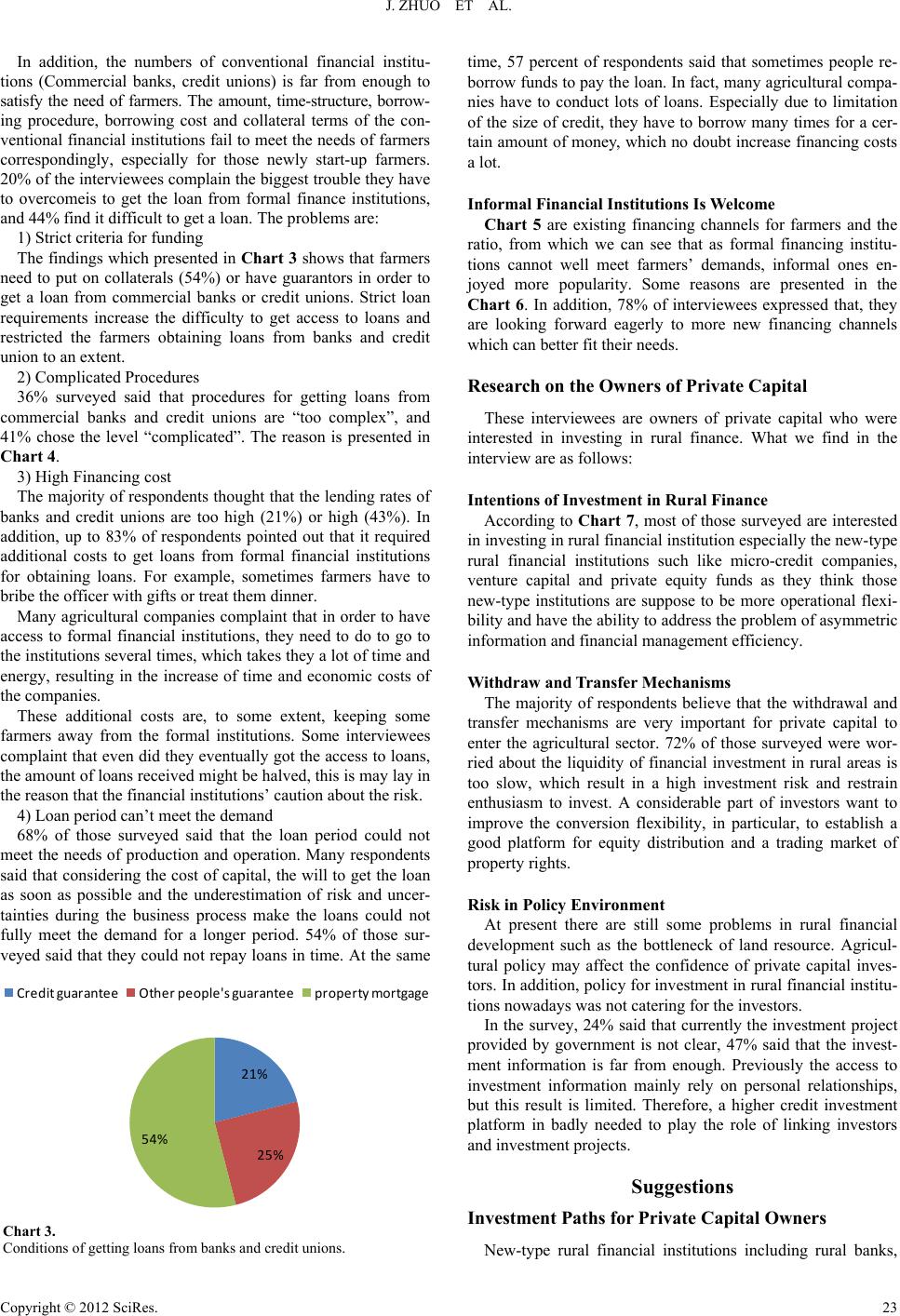
J. ZHUO ET AL.
In addition, the numbers of conventional financial institu-
tions (Commercial banks, credit unions) is far from enough to
satisfy the need of farmers. The amount, time-structure, borrow-
ing procedure, borrowing cost and collateral terms of the con-
ventional financial institutions fail to meet the needs of farmers
correspondingly, especially for those newly start-up farmers.
20% of the interviewees complain the biggest trouble they have
to overcomeis to get the loan from formal finance institutions,
and 44% find it difficult to get a loan. Th e proble m s are:
1) Strict criteria f o r fund i ng
The findings which presented in Chart 3 shows that farmers
need to put on collaterals (54%) or have guarantors in order to
get a loan from commercial banks or credit unions. Strict loan
requirements increase the difficulty to get access to loans and
restricted the farmers obtaining loans from banks and credit
union to an extent.
2) Complicated Procedures
36% surveyed said that procedures for getting loans from
commercial banks and credit unions are “too complex”, and
41% chose the level “complicated”. The reason is presented in
Chart 4.
3) High Financing cost
The majority of respondents thought that the lending rates of
banks and credit unions are too high (21%) or high (43%). In
addition, up to 83% of respondents pointed out that it required
additional costs to get loans from formal financial institutions
for obtaining loans. For example, sometimes farmers have to
bribe the officer with gifts or treat them dinner.
Many agricultural companies complaint that in order to have
access to formal financial institutions, they need to do to go to
the institutions several times, which takes they a lot of time and
energy, resulting in the increase of time and economic costs of
the companies.
These additional costs are, to some extent, keeping some
farmers away from the formal institutions. Some interviewees
complaint that even did they eventually got the access to loans,
the amount of loans received might be halved, this is may lay in
the reason that the financial institutio n s ’ c a u t i o n a b o u t t h e risk .
4) Loan period can’t meet the demand
68% of those surveyed said that the loan period could not
meet the needs of production and operation. Many respondents
said that considering the cost of capital, the will to get the loan
as soon as possible and the underestimation of risk and uncer-
tainties during the business process make the loans could not
fully meet the demand for a longer period. 54% of those sur-
veyed said that they could not repay loans in time. At the same
21%
25%
54%
Credit guaranteeOther people's guaranteeproperty mortgage
Chart 3.
Conditions of getting loans from banks a nd c r e d i t un i o n s .
time, 57 percent of respondents said that sometimes people re-
borrow funds to pay the loan. In fact, many agricultural compa-
nies have to conduct lots of loans. Especially due to limitation
of the size of credit, they have to borrow many times for a cer-
tain amount of money, which no doubt increase financing costs
a lot.
Informal Financial Institutions Is Welcome
Chart 5 are existing financing channels for farmers and the
ratio, from which we can see that as formal financing institu-
tions cannot well meet farmers’ demands, informal ones en-
joyed more popularity. Some reasons are presented in the
Chart 6. In addition, 78% of interviewees expressed that, they
are looking forward eagerly to more new financing channels
which can better fit their needs.
Research on the Owners of Private Capital
These interviewees are owners of private capital who were
interested in investing in rural finance. What we find in the
interview are as follow s :
Intentions of Investment in Rural Finance
According to Chart 7, most of those surveyed are interested
in investing in rural financial institution especially the new-type
rural financial institutions such like micro-credit companies,
venture capital and private equity funds as they think those
new-type institutions are suppose to be more operational flexi-
bility and have the ability to address the problem of asymmetric
information and f i n a n c i a l management efficiency.
Withdraw and Transfer Mechanisms
The majority of respondents believe that the withdrawal and
transfer mechanisms are very important for private capital to
enter the agricultural sector. 72% of those surveyed were wor-
ried about the liquidity of financial investment in rural areas is
too slow, which result in a high investment risk and restrain
enthusiasm to invest. A considerable part of investors want to
improve the conversion flexibility, in particular, to establish a
good platform for equity distribution and a trading market of
property rights.
Risk in Policy Environment
At present there are still some problems in rural financial
development such as the bottleneck of land resource. Agricul-
tural policy may affect the confidence of private capital inves-
tors. In addition, policy for investment in rural financial institu-
tions nowadays was not catering for the investors.
In the survey, 24% said that currently the investment project
provided by government is not clear, 47% said that the invest-
ment information is far from enough. Previously the access to
investment information mainly rely on personal relationships,
but this result is limited. Therefore, a higher credit investment
platform in badly needed to play the role of linking investors
and investment projects.
Suggestions
Investment Paths for Private Capital Owners
New-type rural financial institutions including rural banks,
Copyright © 2012 SciRes. 23